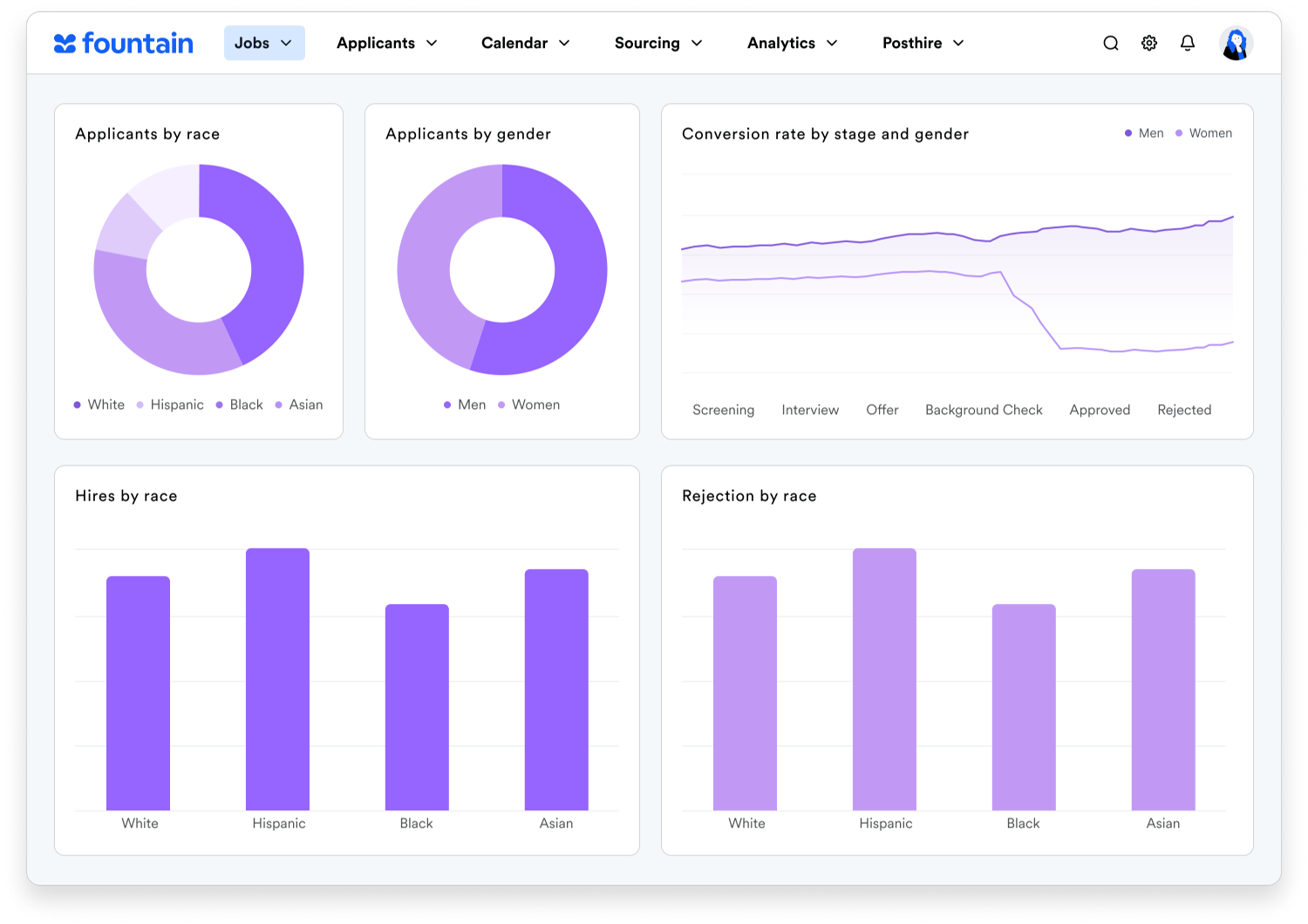You likely know that you need to use ethically sound tactics to attract, hire, and retain your frontline workforce, but did you also know that your practices need to be compliant? HR compliance is the act of using policies and procedures to ensure how you hire adheres to federal, state, and local employment laws and regulations.
Fifty percent of businesses say maintaining compliance is either extremely or very challenging, per a study conducted by Paychex. Companies that aren’t compliant can face penalties like fines or lawsuits that can lead to harsher consequences like bankruptcy.
So how can you ensure your process is HR-compliant? In this post, we’ll reveal the role compliance plays in recruitment, review types of compliance, and discuss best practices to prepare your processes for a potential compliance audit.
The role of compliance in recruitment and hiring
HR leaders are responsible for operating a compliant recruitment and hiring process. Therefore, they need to make sure compliance is a part of their overarching hiring strategy and that is it enforced before, during, and after hiring workers. HR teams need to conduct an internal audit to assess their initiatives around staying compliant, such as consistent employee communication about policies and creating an open channel for employees to report non-compliance.
If an official audit is conducted and hiring practices are found to be non-compliant, companies may be handed penalties, fines, and lawsuits, which can negatively affect the organization’s brand and even lead to employee turnover.

Types of HR compliance
The term “compliance” is quite broad and can apply to multiple levels of regulation and legal mandates. Here, we explore a few examples of compliance as they relate to recruiting and hiring.
- Statutory—This type of compliance focuses on following legislative requirements as they pertain to employment and workplace, such as minimum wage, anti-discrimination, and occupational safety.
- Regulatory—Companies must follow the rules outlined by regulatory organizations such as the Centers for Disease Control and Prevention (CDC) and the Federal Trade Commission (FTC).
- Labor laws—This refers to following labor rules and regulations enforced by national, state, and local legislative bodies.
- Data privacy—Employees need to be assured that their data are protected and kept confidential from breaches and hacks.
- Training—HR teams can employ different types of compliance training to help both recruiters and employees learn more about compliance initiatives.
Get insights, advice, and tips on how to support LGBTQIA+ workers in the workplace.
The role of HR in compliance
HR plays a critical role in ensuring hiring practices are compliant with the regulations above. They need to ensure they have methods and strategies in place to not only prevent but also respond to issues. To do this, they need to start by outlining compliance goals, followed by tasks that may include:
- Including I-9 form completion as a mandatory application requirement
- Conducting background checks
- Offering options for healthcare coverage
- Ensuring fair and equal pay
- Avoiding discriminatory language in job postings and throughout the application process
- Instituting frequent breaks and meal periods
Elements of the hiring process subject to compliance
Several pieces of the hiring process may be open to issues, from recruiting to onboarding. A few examples include:
- Job listings—Ensure the language used in job listings doesn’t show preference to a specific candidate based on age, race, gender, religion, etc.
- Interview questions—Ask appropriate interview questions that pertain only to the job duties, and avoid questions that ask candidates about their personal lives.
- Eligibility documentation—Offer a safe and secure way for candidates to upload their documentation.
- New hire reports—Companies are required to submit “new hire reports” to agencies like the National Directory of New Hires within 20 days of hiring (or fewer depending on the state).
- Classification of workers—Classify workers appropriately based on status (i.e., employees vs. independent contractors; exempt vs. non-exempt).
- Orientation and training—New hires must receive policy and code of conduct documentation before they begin their job so they know how they are expected to behave and how to report harassment.

Common compliance obstacles
Maintaining compliance can be a heavy lift for short-handed recruiting teams. But with the proper preparation and training, you can avoid compliance issues before they arise.
Some common compliance challenges may include:
- Up-to-date information—The onus is on HR teams to stay abreast of national, state, and local employment laws and to make their teams aware of any changes that apply to their duties and organizational requirements.
- Cross-functional collaboration—HR teams need to stay open and communicative with other teams within the organization, such as payroll and legal, to ensure all parties are in compliance.
- Oversight—if any of the hiring steps are not completed with compliance in mind, the organization may be subject to penalties. Therefore, recruiters need to make sure all compliance initiatives are implemented and operate successfully.
- Inadequate compliance methods—If you’re using outdated hiring practices and tools, you may be missing out on opportunities to automate some of these compliance initiatives.
See how Fountain Compliance can help get your compliance practices up and running.
Best practices for ensuring HR compliance
To ensure compliance at every stage of your hiring and onboarding process, we’ve outlined a few best practices.
Stay up to date with standards and regulations
Local regulations can change frequently and without notice. It’s wise to identify a few individuals on your team who are in charge of staying in the know about these changes and communicating them to the wider HR team. This will help your organization stay on top of the latest compliance rules and regulations.
Audit and review your HR policies
In addition to brushing up on compliance regulations, you also should perform regular audits of policies as they grow and change. This act can help prepare you, your team, and the whole organization in case an official audit lands in your lap.

Streamline workflows with a robust tech stack
During your internal audit, it’s worth looking into whether your hiring tools support your endeavors to be compliant. Frontline hiring tools like Fountain Hire usually have such mechanisms built in to ensure you’re offering a fair hiring process for all. If you don’t already have this baked into your hiring flow, search for ways you can add it to make your process more efficient.
Common compliance terminology
When it comes time to establish a thorough compliance check, you may come across terminology only recognizable by a legal professional. Here are a few terms to know. A full list of such terms can be found here.
- Background Check—An investigation that a company conducts into a candidate’s life. This may include (but is not limited to) checking for a criminal record or screening social media accounts.
- Contingent Workforce Management—Contingent Workforce Management (or CWM) refers to the hiring and management of non-permanent workers.
- Employee Assistance Program—An Employee Assistance Program (or EAP) is a benefit program that assists employees with work-related or personal problems that may impact their well-being.
- Exempt Employee—An exempt employee is a worker who is not entitled to minimum wage or overtime compensation. Exempt employees are paid by salary rather than hourly.
- Non-exempt Employee—A non-exempt employee is a worker who is entitled to minimum wage and overtime compensation. Non-exempt employees are paid hourly rather than by salary.
- Human Capital Management—Human Capital Management (or HCM) refers to a set of people resource management strategies applied to the following three categories: workforce acquisition, workforce management, and workforce optimization.
How Fountain can help you stay compliant
As a full frontline workforce management solution, Fountain offers integrations with partners in the HR space that can make completing compliance activities easy and seamless. These include background check providers, document signing, and document uploads.
Fountain Compliance is another solution that allows you to tailor your hiring activities to meet specific regulations and helps proactively engage your workforce to complete compliance-related tasks. By simplifying compliance, you can onboard new workers with confidence.
To learn more about how to implement the right HR tools to help you stay compliant, click here.

